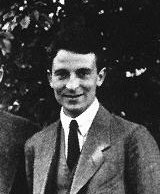Oskar Klein facts for kids
Quick facts for kids
Oskar Klein
|
|
|---|---|

Oskar Benjamin Klein (1894–1977). Photograph taken at the Göttingen Bohr-Festspiele, June 1922.
|
|
| Born | 15 September 1894 Mörby, Sweden
|
| Died | 5 February 1977 (aged 82) Stockholm, Sweden
|
| Nationality | Swedish |
| Alma mater | Nobel Institute University College of Stockholm |
| Known for | Klein paradox Klein–Gordon equation Klein–Kramers equation Klein–Nishina formula Alfvén–Klein cosmology Kaluza–Klein theory Rydberg–Klein–Rees method |
| Awards | Björkénska priset (1937) Max Planck Medal (1959) |
| Scientific career | |
| Fields | Physicist |
| Institutions | Copenhagen University of Michigan Lund University University College of Stockholm |
| Doctoral students | David M. Dennison |
| Signature | |
Oskar Benjamin Klein (born September 15, 1894 – died February 5, 1977) was a brilliant Swedish physicist. He studied the basic rules of how the universe works.
He is especially famous for his ideas about string theory and the Kaluza–Klein theory. This theory suggests there might be extra hidden dimensions in space!
Contents
Oskar Klein's Early Life and Education

Oskar Klein was born in Danderyd, a town near Stockholm, Sweden. His father, Gottlieb Klein, was the chief rabbi of Stockholm.
From a young age, Oskar showed great talent. He became a student of Svante Arrhenius at the Nobel Institute. This was a very important place for science.
He planned to study in France, but World War I started. He had to join the military instead.
Working with Great Scientists
After the war, Oskar Klein worked with the famous physicist Niels Bohr. This was at the University of Copenhagen in Denmark.
In 1921, he earned his doctoral degree from the University College of Stockholm. This school is now known as Stockholm University.
In 1923, he moved to the United States. He became a professor at the University of Michigan in Ann Arbor. He moved there with his wife, Gerda Koch.
Klein returned to Copenhagen in 1925. He also spent time with Paul Ehrenfest in the Netherlands.
Becoming a Professor
In 1926, Oskar Klein became a teacher at Lund University in Sweden.
Then, in 1930, he became a physics professor at Stockholm University College. He held this important position for many years.
He was honored with the Max Planck Medal in 1959. This is a very high award for physicists. He retired from teaching in 1962.
Key Discoveries and Ideas
Oskar Klein made several important contributions to physics.
The Klein-Gordon Equation
In 1926, Klein discovered an important equation called the Klein-Gordon equation. This equation helps describe how tiny particles behave. It was a big step in understanding relativistic wave equations.
Other scientists, Walter Gordon and Vladimir Fock, also found this equation around the same time.
Extra Dimensions in Space
Klein is also famous for an amazing idea about dimensions. He suggested that there might be extra dimensions in our universe. These dimensions could be real but are "curled up" and very tiny. We cannot easily see them.
This idea is a key part of the Kaluza–Klein theory. It is also very important for string theory, which tries to explain everything in the universe.
Understanding Weak Interactions
In 1938, Klein proposed a model for how certain forces work. These are called weak interactions, which cause things like radioactive decay. His ideas were similar to those of Hideki Yukawa.
Klein's model helped pave the way for later theories, like the successful Yang–Mills theory.
Legacy and Recognition
Oskar Klein passed away on February 5, 1977, in Stockholm, Sweden.
His work continues to inspire scientists today. The Oskar Klein Memorial Lecture is held every year at Stockholm University in his honor.
Also, The Oskar Klein Centre for Cosmoparticle Physics in Stockholm is named after him. This center studies the universe and tiny particles.
Oskar Klein was the grandfather of Helle Klein.

